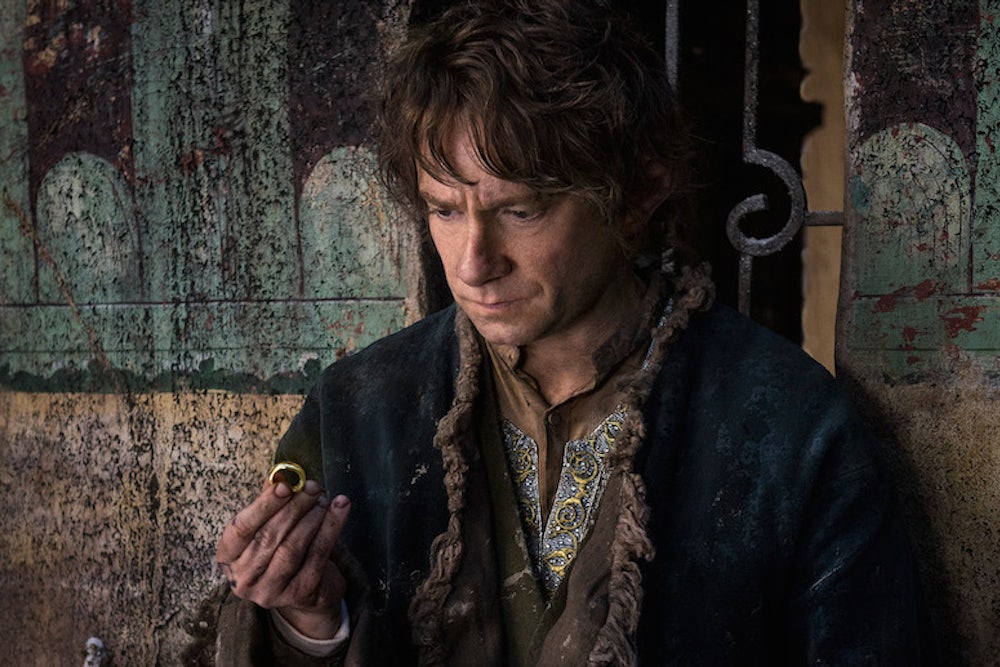On Wednesday, the final movie in the Hobbit trilogy will hit theaters, bringing to a close a cinematic saga that has spanned six movies and thirteen years. Peter Jackson has said this will be his final foray into Middle-Earth, and since the Tolkien estate looks unlikely to cede the rights to more works, we should take him at his word.
There might be another reason Jackson is giving up the ghost. While the three Rings movies won 17 out of 30 Oscar nominations—The Return of the King recorded the biggest Oscar sweep in history—The Hobbit trilogy, on the other hand, has yet to win any Oscars. The difference isn’t so dramatic at the box office, but the Rings gained momentum with each release, making around $30 million more with each subsequent installment. The Hobbit movies, on the other hand, become less popular each time. The Desolation of Smaug made $50 million less than An Unexpected Journey.
Some of this is due to the fact that the Hobbit trilogy adheres too closely to the spirit and scale of The Lord of the Rings, losing the childish charm that makes the book such a delight. (That, and the studio decided to cash in by stretching a short book into three lengthy movies.) But the problem runs deeper: Hollywood has changed dramatically in the thirteen years between Fellowship and Five Armies, and Peter Jackson is the victim of his own success.
We live in a cinematic era of franchises. Marvel alone has already announced an onslaught of 29 superhero movies in the next six years, the 88-second teaser for the Star Wars reboot has 48.6 million views on YouTube after only two weeks, and it’s now routine to split the last installment of trilogies into two parts (see The Hunger Games or Twilight).
In 2001, when Fellowship of the Ring kick-started the Jackson/Tolkien collaboration, sprawling movie franchises were not yet standard Hollywood cash cows. When Jackson was in negotiations for The Lord of the Rings, he actually had a hard time convincing studios to let him make two movies, let alone three. It was only at the behest of New Line Cinema CEO Bob Shaye that Jackson received permission to make one movie per book. At that time, it was considered a daring, risky move, and Jackson famously shot all three movies in one go to save the studio money and to ensure all three would be made even if Fellowship failed.
James Bond was around, of course, but those movies came out at inconsistent intervals and were mostly unconnected in plot. Franchises like Star Wars and National Lampoon did exist, but they were the territory of genre cults rather than the mainstream default. In 2000, the top-grossing movie was How the Grinch Stole Christmas, and only three of the most lucrative 25 movies that year were part of franchises. In fact, between 1997 and 2000, there were on average four franchises in the top 25 each year, many of which were originally intended to be only one film, such as Rush Hour and Scary Movie. It was in 2001, the year of not only Fellowship of the Ring but also the first Harry Potter movie, that franchises began taking over. The overwhelming success of those movies convinced studios that this franchises worked. It’s easy, after all, to market to a preexisting, loyal fanbase. Nowadays, it’s practically expected for blockbusters to come in parts.

Jackson helped to make that practice the norm, and by the time he made An Unexpected Journey in 2012, around half of the top 25 movies each year were franchise properties. In the early 2000s, The Lord of the Rings primarily competed with Harry Potter and Star Wars. Today, Batman, Spider-Man, Marvel’s unending array of caped heroes, Bond, the Twilight vampires, Katniss Everdeen, Kirk and Spock are all crowding out Bilbo, Gandalf, and company. It’s no wonder the Hobbit movies don’t get as much attention; there’s simply too much competition.
It’s not only franchises that Jackson—to his own detriment—helped to popularize, but also the epic fantasy. The Lord of the Rings made it seem that nothing was unfilmable (as long as a flight to New Zealand was feasible), and whetted the mainstream appetite for epic spectacle. So much of the trilogy’s appeal lay in the sheer scale of it all—the breathtaking sets, the spectacular vistas, the exhilarating battles. As Peter Travers wrote in Rolling Stone at the time: “What a kickoff. Fellowship is the real deal, a movie epic that pops yours eyes out, piles on thrills and fun, and yet stays intimately attuned to character.” The Hobbit trilogy still has all of that—some of it literally replicated—but it has lost its ability to shock us in the precisely the same way because those elements have become part and parcel of fantasy filmmaking. Less-successful imitators—the Narnia series, Eragon, The Golden Compass, The Spiderwick Chronicles—all attempted to replicate the Jackson-Tolkien formula and normalized the fantasy experience. It is no longer spectacular, but expected, for the camera to glide over 10,000 Orcs ready for war. Audiences can see that sort of thing every Sunday on Game of Thrones.
It’s a common sentiment that the Hobbit movies just make people want to rewatch The Lord of the Rings. But as we say goodbye to Middle-Earth for the final time, take a moment to appreciate what Peter Jackson has done for the movies in the thirteen years since he first brought us Hobbits, Orcs, and Elves. The Hobbit movies aren’t as good as their predecessors, but that’s because The Lord of the Rings revolutionized the way movies are made and our expectations in watching them. Jackson may be an architect of his own demise, but what he created in the first place was glorious.
